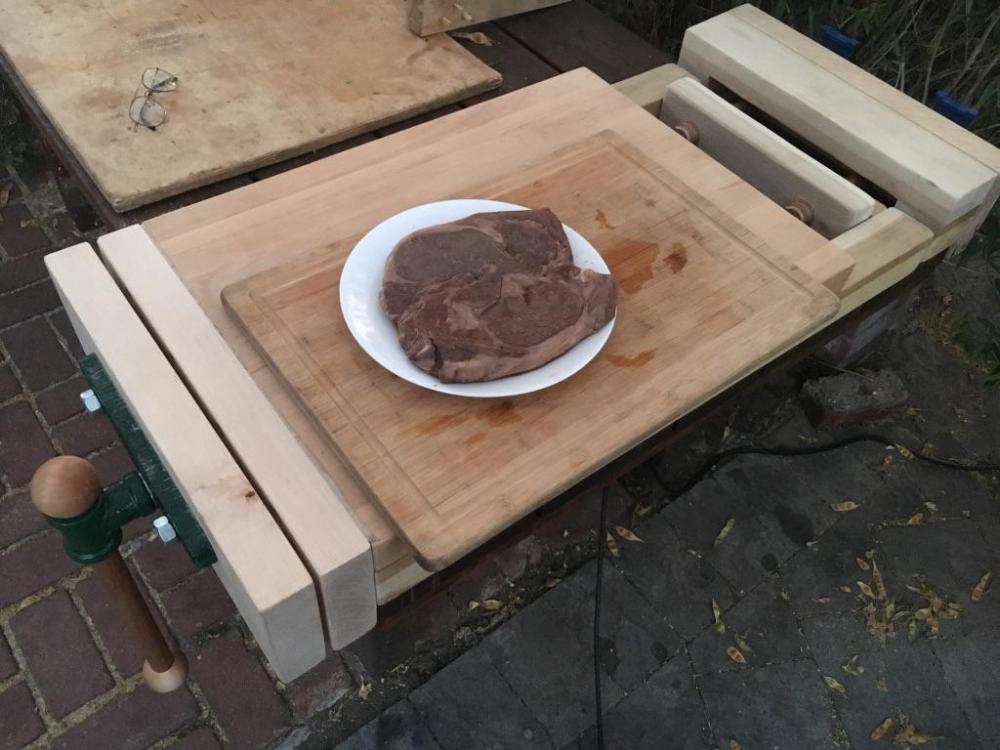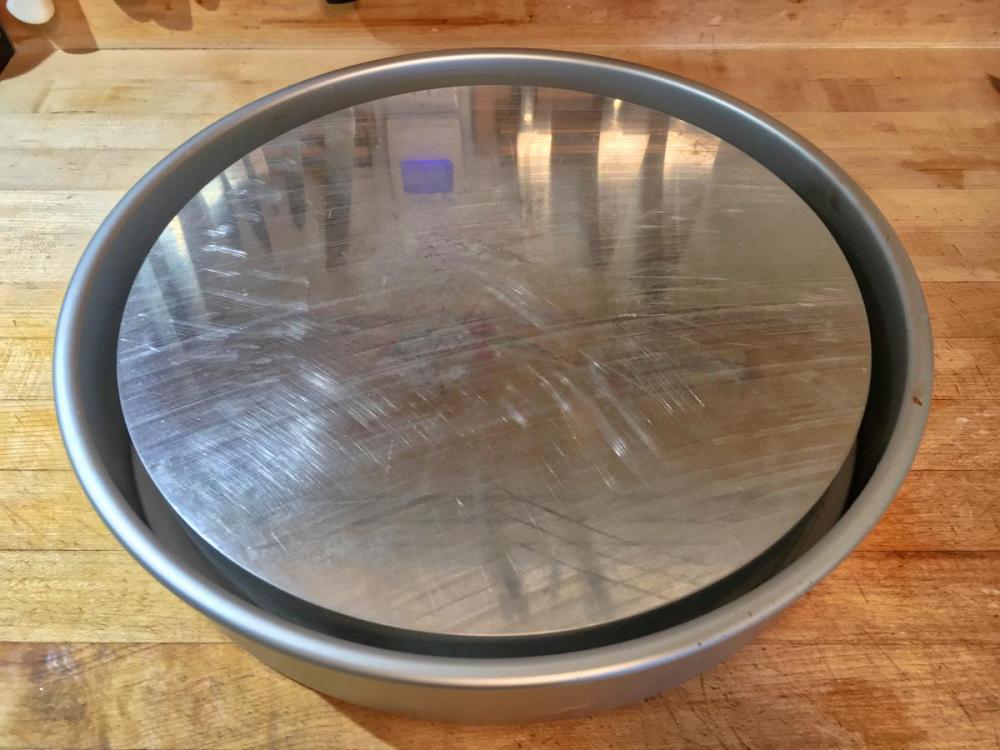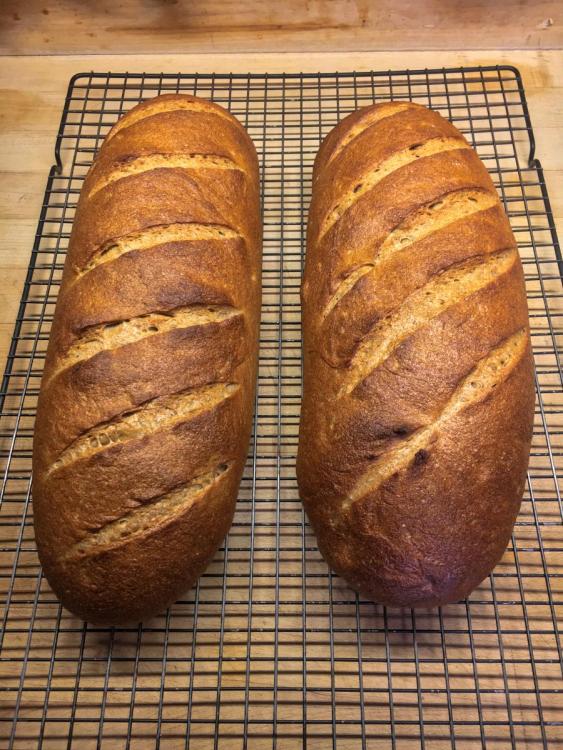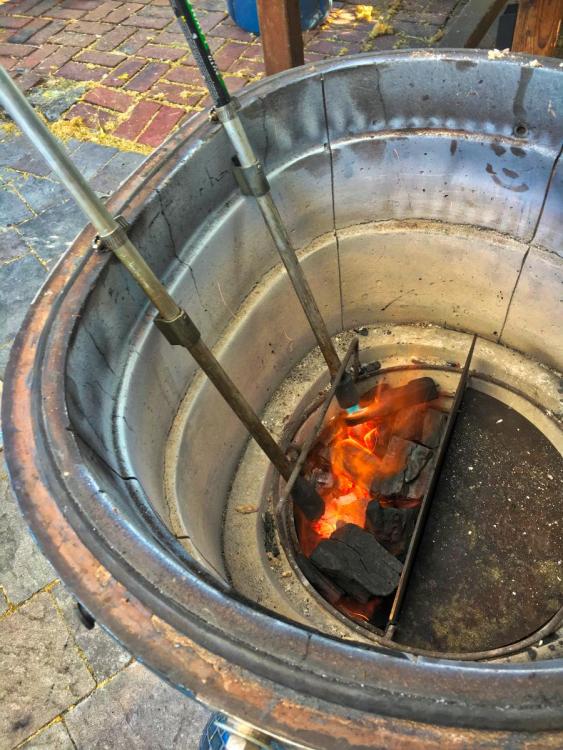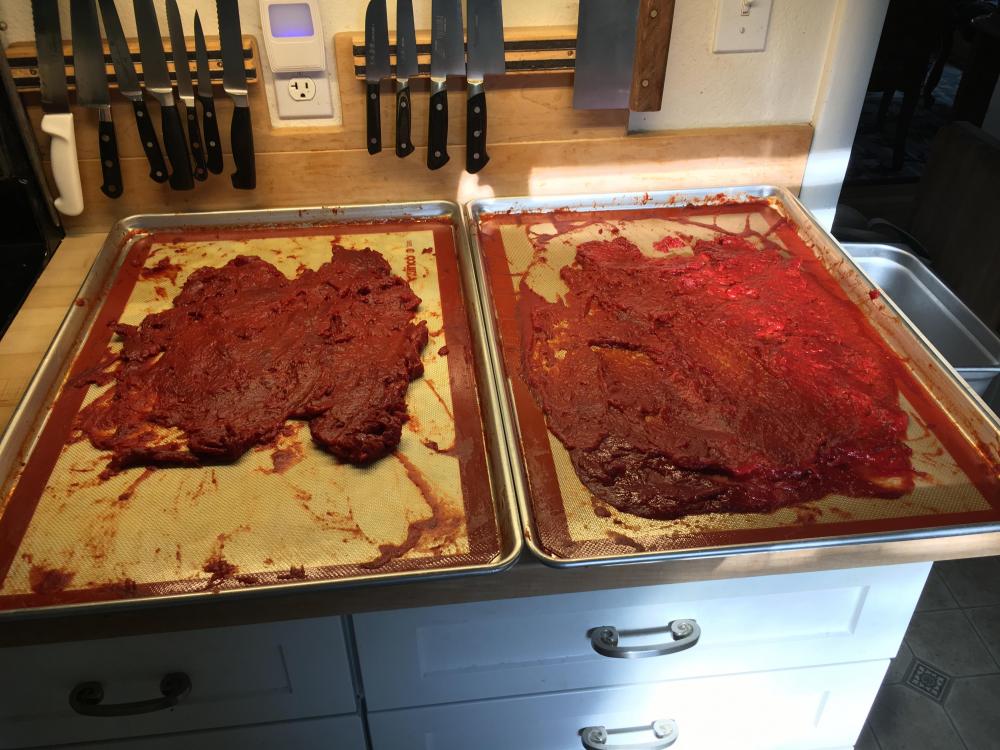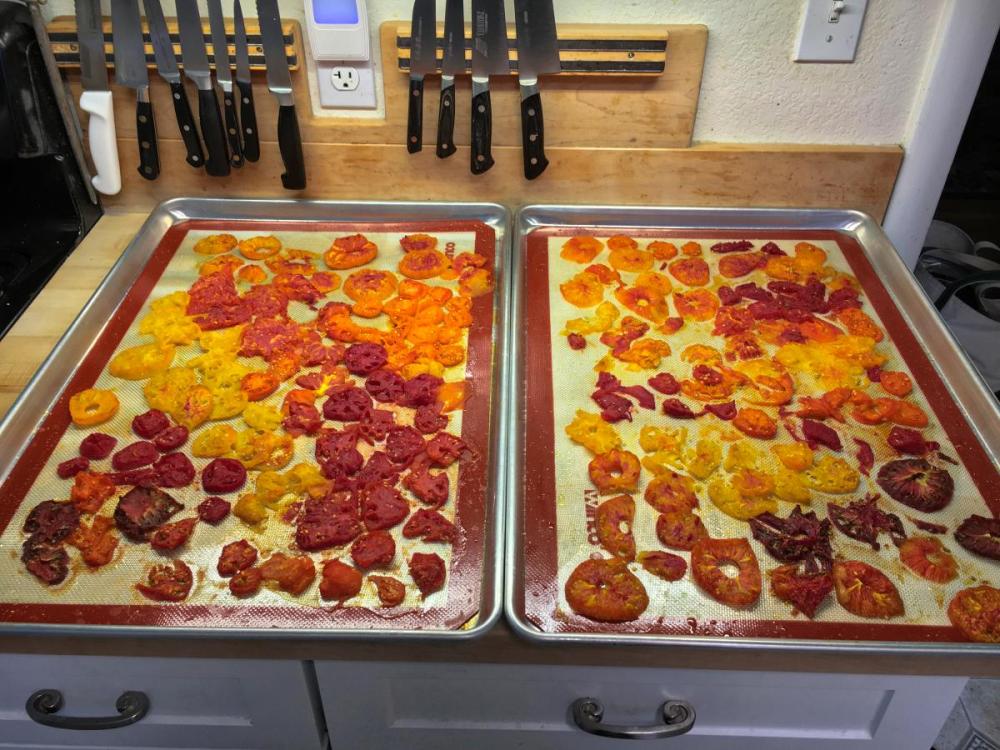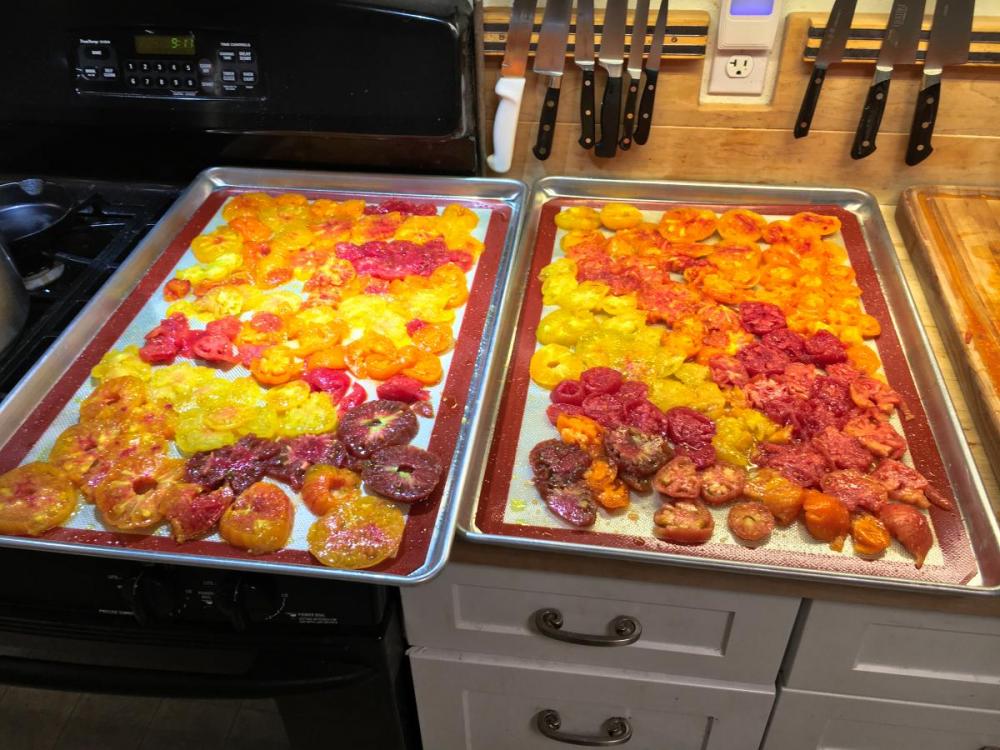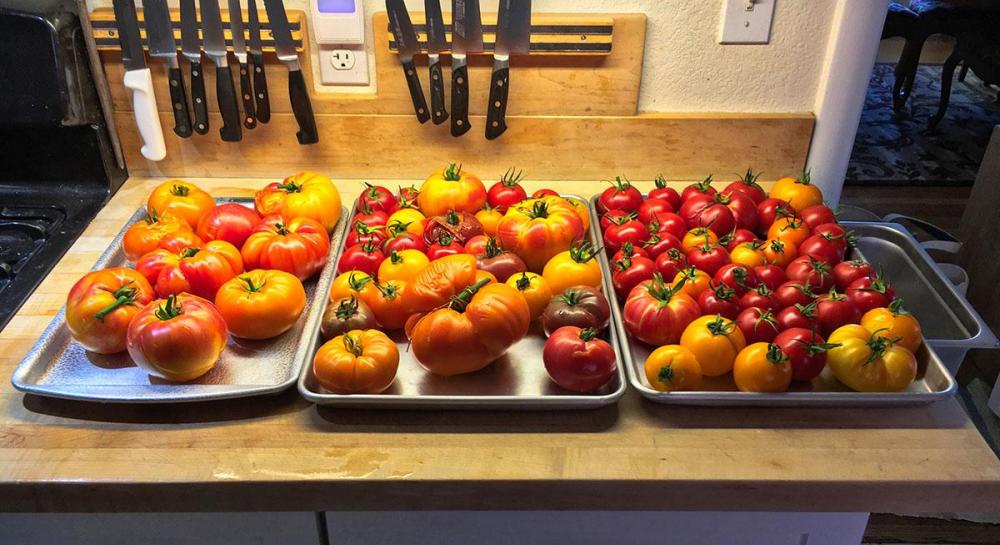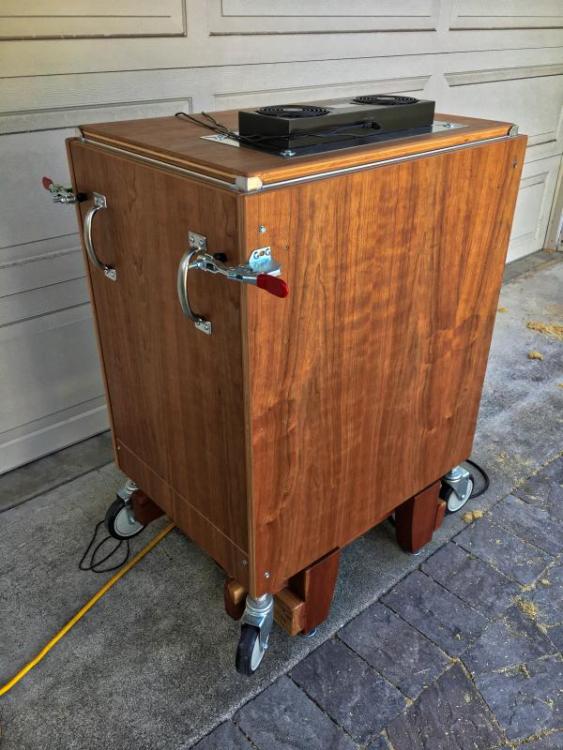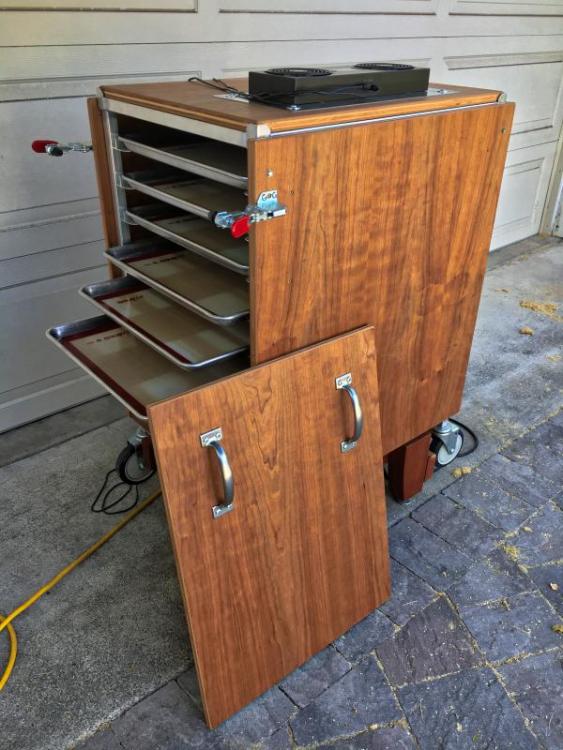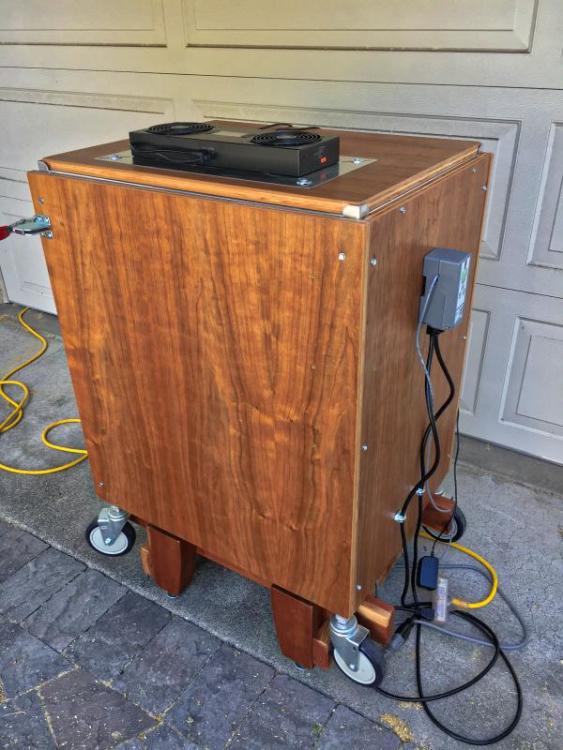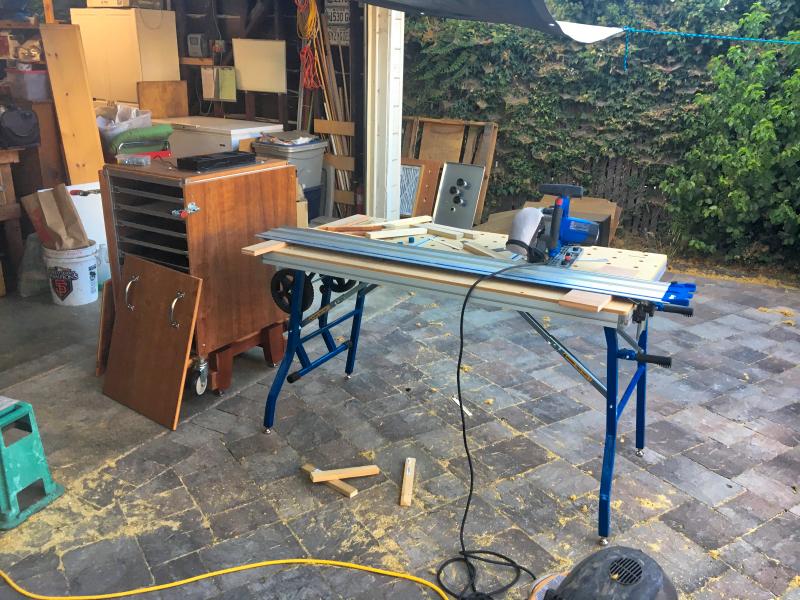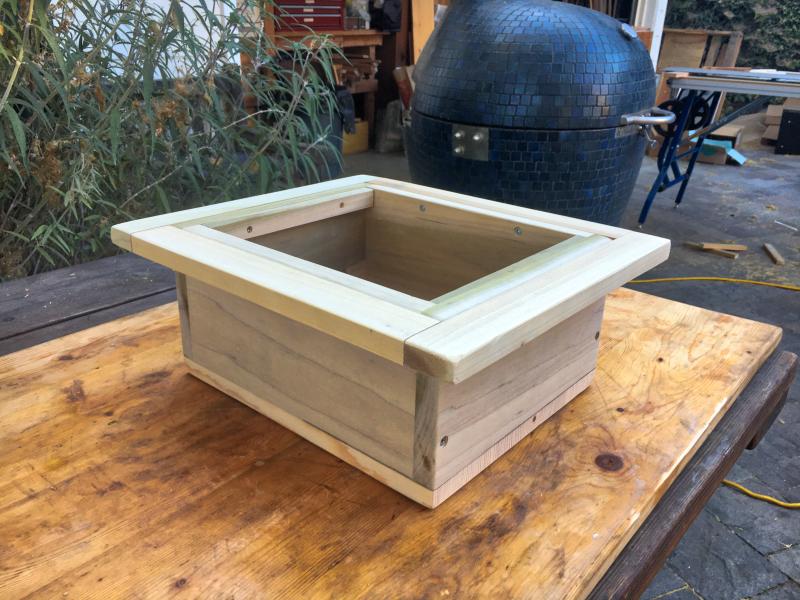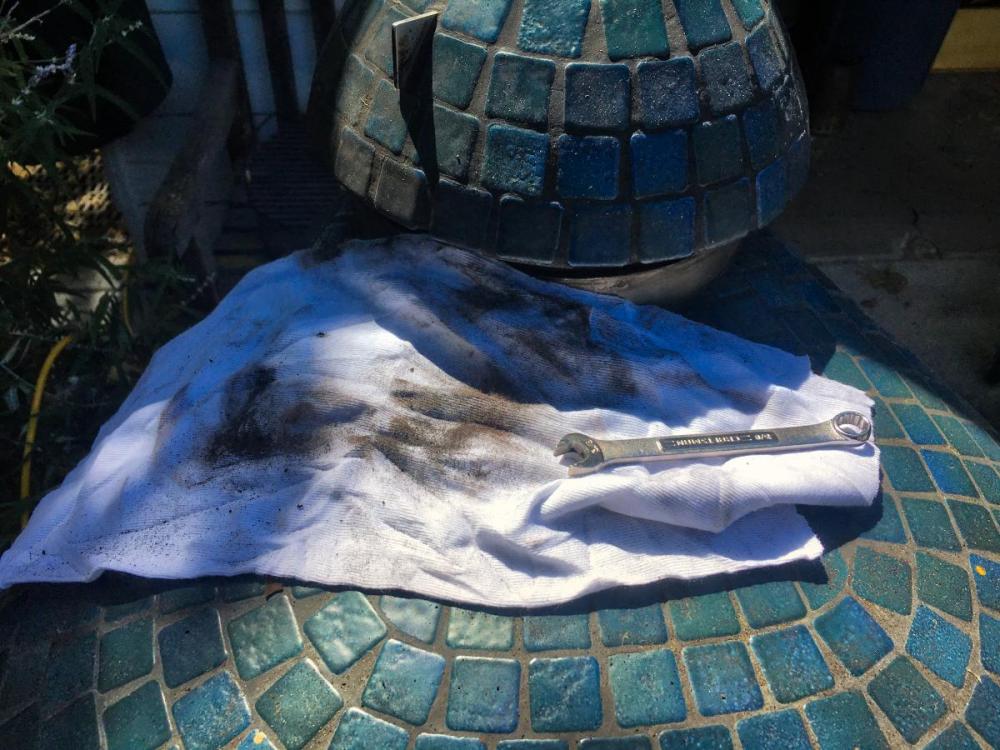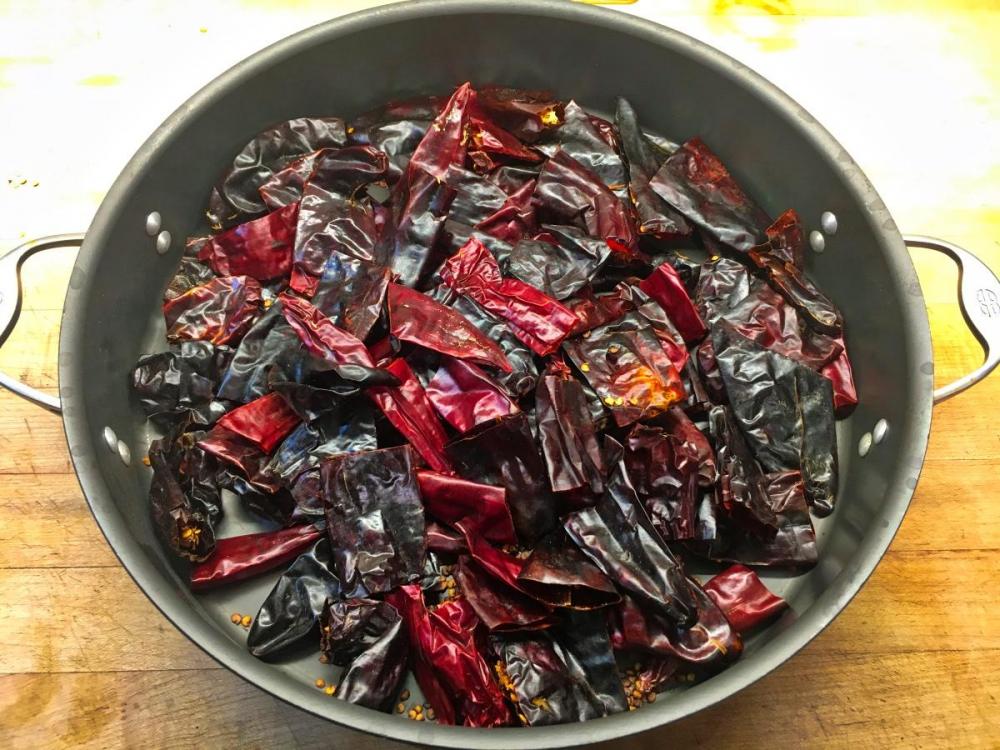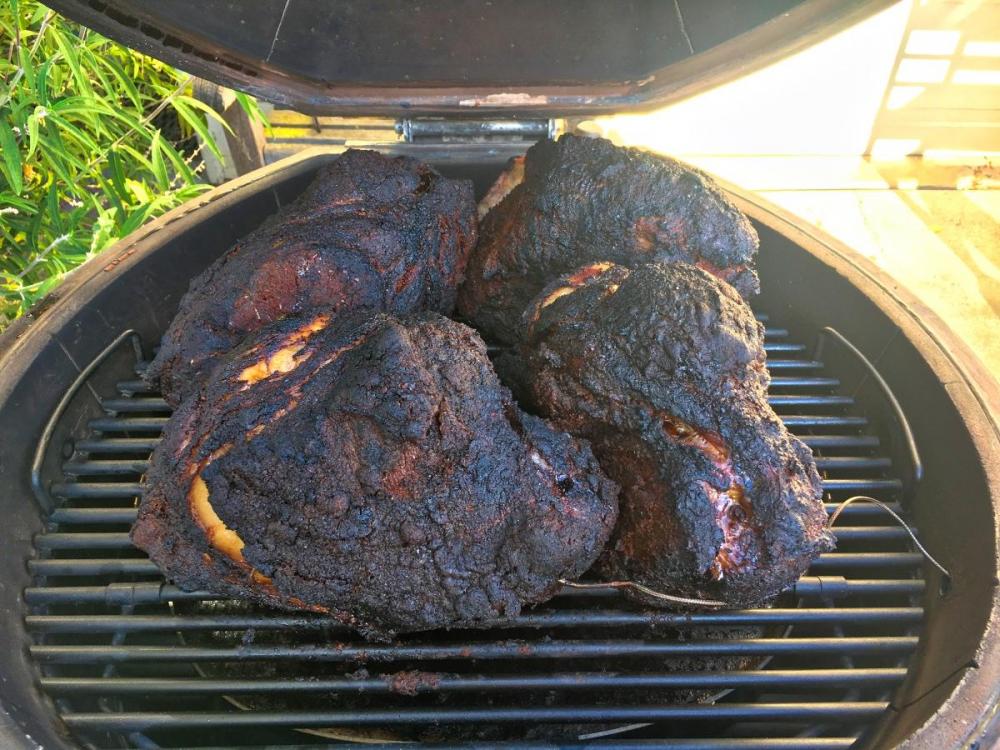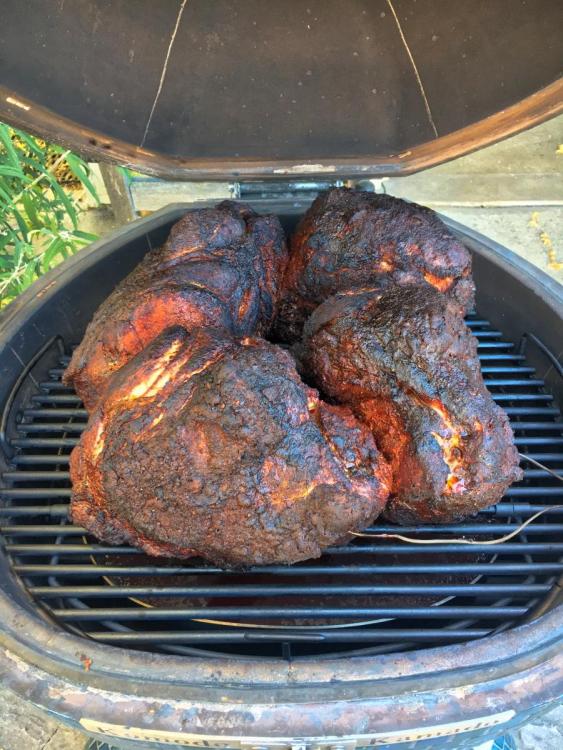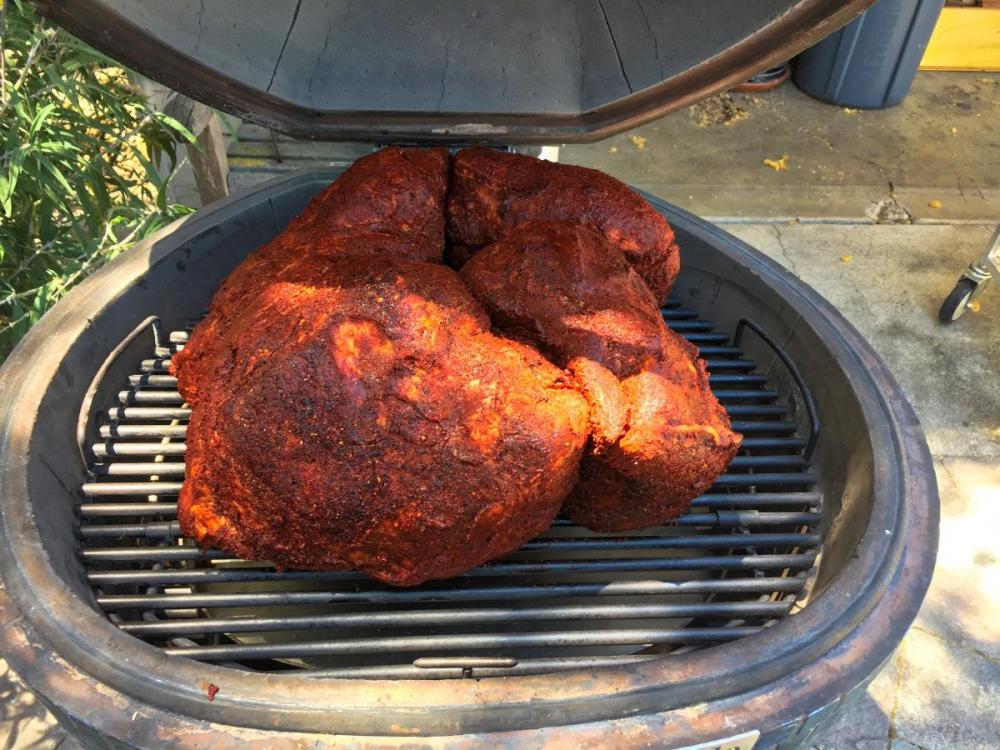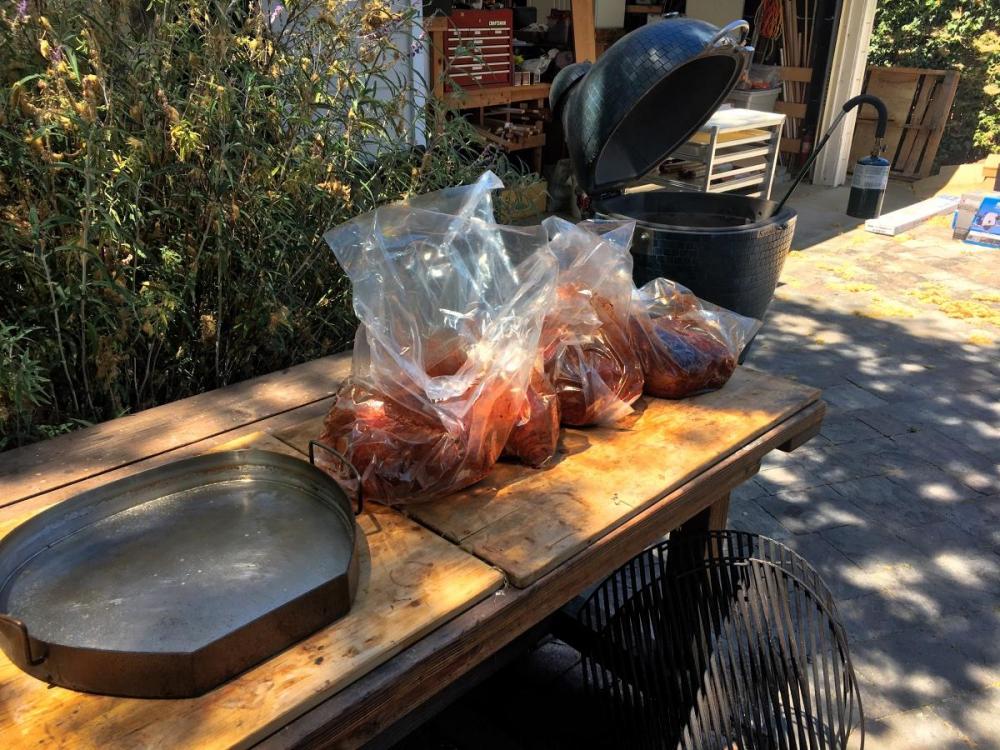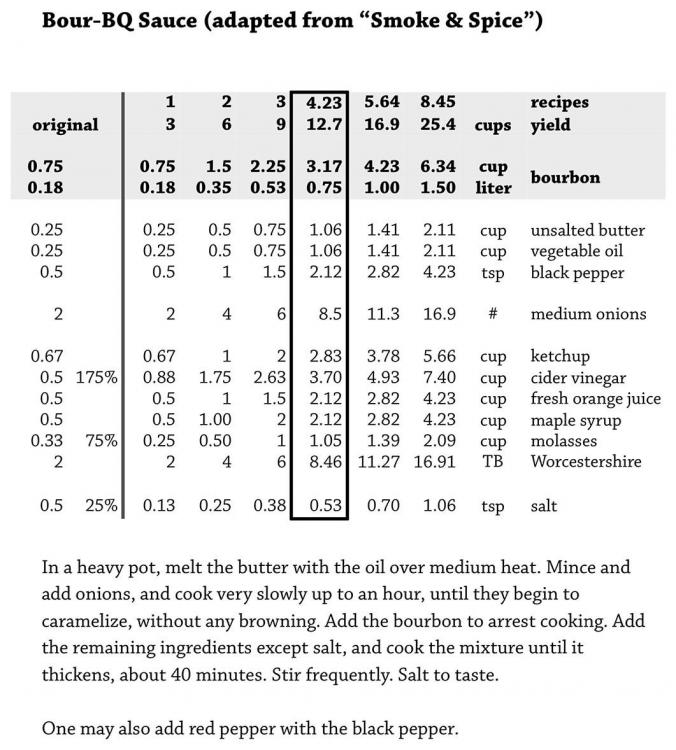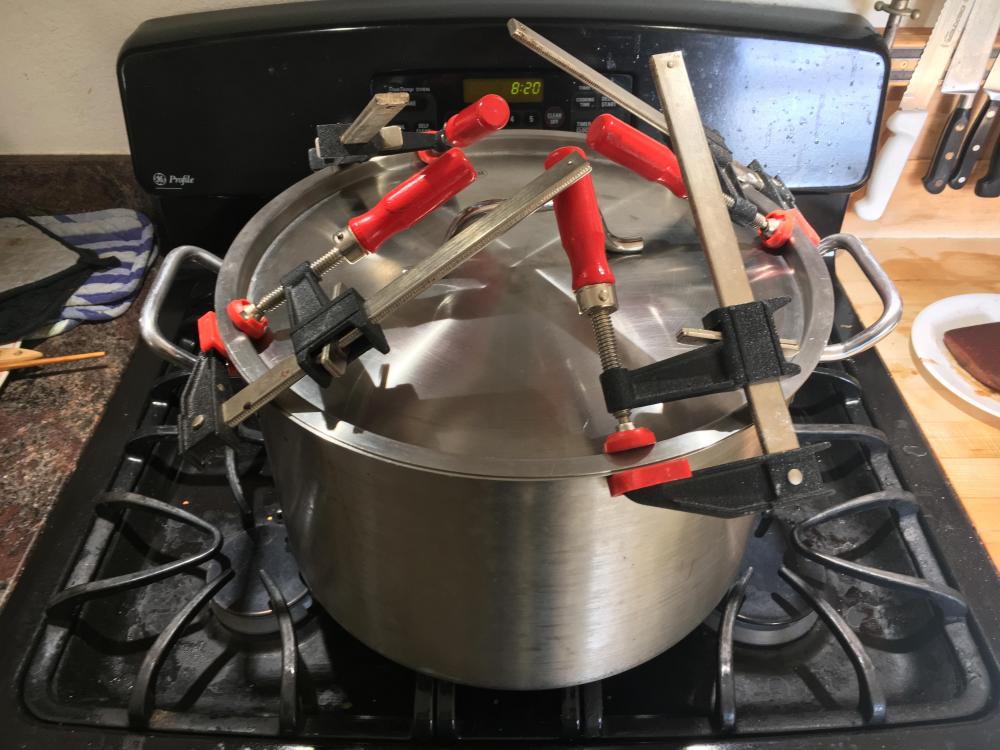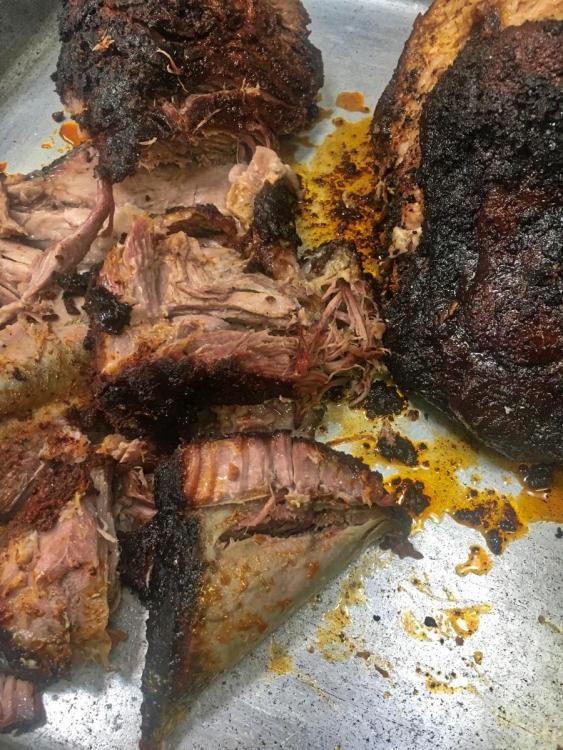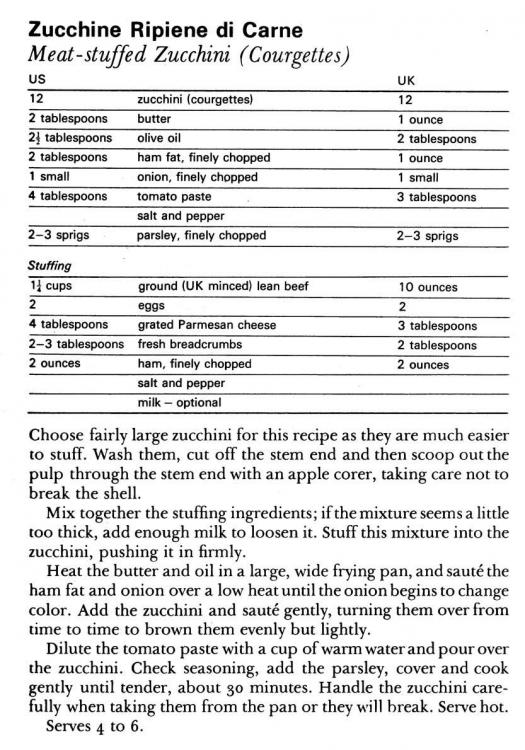-
Posts
1,740 -
Joined
-
Last visited
-
Days Won
53
Content Type
Profiles
Forums
Events
Everything posted by Syzygies
-
-
I'm waiting for a Jessum router table that cost a fair fraction of what I paid for my KK. If the other end is closed, I can imagine a captive nut to help hold everything in place. Or, place an order at Ponoko to form fit the wrench, and fit that into a nice wood handle, with appropriate glue. In any case, making a few of these is clearly in my future.
-
Bouchon Bakery recommended stones. Huh. I figured get water inside stones, heat to 450 F, you're making a bomb. No way. I started with cast iron and steel, and stumbled onto aluminum.
-
That calculation is for two plates. One shouldn't trust other people, ever, to do numbers. Let me explain my calculations so you can check me: A calorie is the energy it takes to raise a gram of water one degree centigrade. It takes 80 calories to thaw a gram of ice, 100 calories to bring that gram to the boiling point, and 540 calories to then turn that gram of water to steam. When the steam condenses, it releases that same energy. That's why steam burns are so severe. That's why the bread loaf notices we're doing this. By weight, aluminum holds 21.5% as much heat energy as water. This is better than steel, at around 13%. Water has a specific heat capacity of 4,181. Aluminum has a specific heat capacity of 897. The fraction 897 / 4181 = 0.2145. I bake at 450 F = 232 C. That's 132 C above the boiling point 100 C of water. My cake pan with two aluminum disks weighs 44.9 pounds. 44.9 * 454 = 20,385 grams. Scaling by 0.2145, that's the same heat capacity as 4,373 grams of water. 4,373 grams of water times 132 C above boiling = 577,236 calories of energy for us to play with. To turn ice to steam in the KK, we need 80 + 100 + 540 calories per gram of ice, or 720 calories. Our 577,236 calories divided by 720 is 800 grams of ice. 400 grams of ice is plenty, so one aluminum disk is plenty. A facility with math lets one shorten all this substantially in one's head, or write a spreadsheet, but anyone can work through each sentence one at a time, and understand what's going on here. If one wants to check my research, in addition to my calculations, here is a site describing turning ice to steam, with numbers matching mine: Heat Energy Required to Turn Ice into Steam The ratio of specific heats between aluminum and water is what matters here, not the units or their definitions, which can get confusing. Here's a table that yields similar ratios to mine: Table of Specific Heats And there's an age-old tension between theoretical physicists and experimental physicists (I am neither). Theory is only good for puzzles unless it works. In my experience, these calculations work.
-
Same recipe (tweaked over the years using a spreadsheet). Different results, both great. I won't even try to describe the differences, as I'm never convinced when someone uses florid language to describe wine, I don't see how I could do better with bread. Really, I like Bâtards because I can slice them to fit in the toaster. Finding a cast iron dutch oven in this shape is a frequent bread forum question; here is their preferred choice, available from various suppliers: Bayou Classic Cast Iron Oval Fryer I like to make two loaves (same work as one loaf), and the steam is easier than juggling two heavy pieces of cast iron. I've been burned both ways; steam burns are far easier to avoid by simply following a proper protocol: Use a slab of ice, or (indoors) wear a silicone mitt. I wouldn't say I'm riled up. I do like clarity. Some people are more difficult online; I'm probably more difficult in person. As my wife says, we're high maintenance, but we do our own maintaining.
-
Wow, how timely to find this thread active. I also have news to report. I got tired of cleaning yard schmutz out of my stainless steel chains, so I ordered a second aluminum disk off eBay. My steam generator now consists of one cake pan and two disks, all aluminum: Fat Daddio's PRD-163 Round Cake Pan, 16 x 3 Inch, Silver 1 Aluminum Disc, 1 1/4" thick x 14 3/4" dia., Mic-6 Cast Tooling Plate, Disk To my surprise redoing my calculations, aluminum has a significantly higher specific heat capacity than steel: Water, 4181. Aluminum, 897. Ratio: 21.5% Moreover, these disks are heavy. The cake pan and two disks combine to 44.9 pounds. So, in a ceramic cooker or oven heated to 450 F, this steam source can boil off 803 grams of ice, or 964 grams of warm (40 C) water. I rarely use more than half that, enough steam to replace the air in a KK or oven several times over. Perhaps I should have just tossed the steel chain, but now I have two aluminum disks. Nice. As for the no-knead discussion, is there any connection between no-knead recipes and cast iron enclosures? Or are we all playing Simon Says? Are the authors assuming no one is crazy enough to generate steam as Thomas Keller advises? A cast iron enclosure, and a steam generator, both work. They work differently. If no-knead bread is wedded to a cast iron enclosure for some technical reason, I'm all ears. I'm not seeing it. I've tried both ways with my bread (derived from Tartine Bakery which is a nuanced version of no-knead), and steam is better. What pushed me to experiment was a desire to pick my shape and make multiple loaves at once, not to be forced into the shape of the cast iron enclosure.
-
That is excellent news. Here's wishing for a speedy recovery. That's a serious workout schedule. It was pretty clear one can under-do it (telling my doctor I'd work out never helped much, but an actual half hour swim each day changed all my numbers). But one can over-do it? Wow.
-

Starting charcoal and maintaining temperature
Syzygies replied to coolpapabill's topic in Komodo General
I use a pair of propane weed burners to light charcoal, then a Milwaukee cordless leaf blower to blow sparks around everywhere. I bought the second weed burner when the first one stops igniting. I then realized you really only need one to light itself, it can light the others. So I kept both. If you make a habit of using two burners, and one propane canister runs out, you still have the other. Note the hose clamps, so I can balance the weed burners on the edge of the KK. Adjust to taste. I've heard of MAPP gas. My trouble is I'm adequately handy at too many things, including sweating pipes for plumbing. I do it so infrequently that I forget I can't work quickly enough to use MAPP gas rather than propane. It's like landing a jet compared to a propeller plane. It all happens twice as fast, and it might go well... So I only stock propane. In any case, once one gets a flame going, increasing the air supply does far more to establish the fire than continuing to apply an external flame. Dennis used to use a hair dryer. The Milwaukee leaf blower is pretty anemic for blowing leaves, which makes it perfect for getting fires going. If I actually want to clean up our yard without gasoline fumes, I use an EGO leaf blower that takes my EGO lawn mower battery. The dog charges me when I use it, she thinks I'm being misguided. -
Well, I did have to replace my gasket recently, though I don't think the steam did it. Just time. I highly recommend a gasket change if warranted; it's like sharpening a knife. My KK runs so much better now. I am hard on cookers. I basically destroyed a Richard K. My KK can take everything I give it.
-
Yes. Let me give a meta-answer: Commercial bread ovens inject a great deal of steam at the beginning of the cook. This is a lot of trouble to design; they must have a good reason. Individual cooks can come up with some pretty whacky explanations for why things work. Trust their observations that things work, but don't accept their explanations. I learned this for example working on what is perhaps my best-known theorem: It takes seven shuffles to randomize a deck of cards. One piece of evidence that people under-shuffled was the outrage from duplicate bridge players when tournaments switched to dealing hands by computer. The players astutely observed shifts in game play, but wrongly believed that the computer was doing a worse job of shuffling than humans. I believe that the effect of steam at the beginning of a bread bake is this: Just as it takes a great deal of energy to convert water to steam, a great deal of energy is released when steam condenses back to water. One needs to be attentive working with steam; a steam burn could easily put you in the hospital. So at the beginning of a bread bake, what's cold in the oven? The loaf of bread. Steam condensing on the bread delivers a giant burst of heat energy to the crust. I observe better oven spring, and a better crust. There is however an ensemble of effects. The process is simply different. Proponents of baking no-knead bread in a cast iron pot often claim that the cast iron pot traps steam, also replicating the steam injection in a commercial bread oven. Huh? Their method also produces good bread, but it's totally different. There is no initial surge as steam condenses to water. The crust is interesting, much better than not using the pot, but not the same. I'm reminded of debating programming languages. Never debate programming languages with someone who isn't proficient in each language under discussion. Too many proponents of no-knead bread are no damn good at baking conventional loaves, and I simply don't trust anything they have to say. Confirmation bias, they like no-knead bread and they don't like kneading. I get it. The truth here is much more subtle. Chad Robertson for example advocates a very precise method of turning dough in a bowl, a very light kneading, that works well with baking in a cast iron pot. I bought some Danish landrace wheat flour at a farmers market this morning, and the directions about a long hydrolyze and the faintest knead were carefully given. If one isn't versed in both no-knead and classic kneading techniques, one doesn't have the skill set to adapt to actual conditions. Die-hard no-kneaders are simply dogmatic, they're not taking in new information.
-
Definitely never let galvanized metal anywhere near a BBQ cooker. When heated, the fumes include zinc, and too much zinc can be toxic. Is Galvanized Steel Toxic I've been using stainless steel chain from Home Depot: Stainless Steel Straight Link Chain Cast iron doesn't hold up so well in this application; I've switched to a 16" cake pan. I'm not aware of any health issues involving aluminum; the dementia scare from decades ago was a false alarm: Fat Daddio's PRD-163 Round Cake Pan, 16 x 3 Inch, Silver One can buy metal disks on eBay, apparently left over from cutting big holes. This disk nicely fits a 16" cake pan. One could use two disks and skip the chain; I use one disk and chain: 1 Aluminum Disc, 1 1/4" thick x 14 3/4" dia., Mic-6 Cast Tooling Plate, Disk I wondered if this would work as well as chain. In fact it appears to work better. The water ends up in the moat between the disk and the cake pan, and the disk conducts heat quickly to boil the water off. Now, I don't understand how the chain works! Most of the chain never contacts water. It does work, as we've observed. I review the physics in my first post in this thread: Comment One needs 30 lbs of thermal mass, one way or another, to boil off 350g of water or ice. Commercial bread ovens simply inject steam at the beginning of a bake, and plenty of it. Thomas Keller popularized the idea of reproducing this steam at home, though this didn't originate with him. He sure got a lot of flack over this in various forums; many cooks have a crippling lack of any sense of scale, and believe that a 10g spritz from their plant spritzer has the same effect. The Bouchon Bakery book proposed rocks in a sheet pan. I don't like that idea; steam in the wrong place could make a rock explode. But rocks have a similar heat capacity to metal: About 1/7th that of water. That's why one needs so much metal to boil off so little water.
-
A 20 pound box of dry-farmed Santa Cruz Early Girls, into 5 pounds of paste. It seems like more than a 4:1 reduction, but dry-farmed tomatoes start with less water. There's a vintage effect. This year's paste is nowhere near as sweet as last year's paste. They had a rainy Spring leading to a late crop; it's just now possible to buy boxes. The Silpat non-stick silicone baking mats were a revelation. I would have bought a commercial dehydrator if I could have figured out how to contain quarts of puree per tray. Instead, the Silpat liners drove the design process. They fit full sheet pans, which fit bakery racks, figure out something starting from there. The non-stick is amazing: I had thin dried films on the edges everywhere, starting with six trays, two quarts of puree per tray (1/3 of nominal capacity; the trays hold six quarts each to the brim). I thought this was a lost cause, to soak off later. Instead, the films peeled off cleanly like separating the protective film from double-sided tape. Mixed back into the paste, these films tend to equalize and rehydrate.
-
Here are before, after photos of about 10 pounds of garden tomatoes. Far less effort that using, cleaning a stack of Nesco American Harvest dehydrator trays with fruit roll inserts, and the drying is more uniform. These are dried till most of the water is out, but the tomatoes are still "gooshy". This greatly enhances the flavor; it's how we make many midweek quick tomato sauces during the year. The tomatoes will now be vacuum packed and frozen in roughly 210g packets, each representing two pounds or so of tomatoes. This weekend I hope to make paste.
-
His work is amazing: Sam Maloof Woodworker I oscillate between obsessed with walnut and obsessed with cherry. This was opportunistic cherry, it will turn red with more sun. My next door neighbor is a master woodworker; he used to work at Berkeley Mills and now has his own shop other side of our fence. Steve Jobs lived in an empty mansion because nothing was good enough for him, until he bought Pixar and they walked him down the street to see Berkeley Mills. In any case, my neighbor has a serious problem with exotic scrap wood; we've sat around fires that included bits of mahogany and teak. We've bought various pieces from him (outdoor table that used to be theirs, solid cherry kitchen table, an exact reproduction/replacement for particle board box store bathroom vanity in solid cherry). Much of the storage in my garage is from his "customer changed their minds" cabinetry. This was an unneeded sheet of 7-ply (middle layer MDF) plywood with Cherry veneer, that he sold me. I loved the math involved in how he reworked my cut list, to get new edges on all sides with a minimum number of cuts. I love my $900 Kreg track saw table, but his table saw is in a different league. In any case, they're also flooded with tomatoes, and they'll be using this dryer too. In Sicily they spread paste on tables in the sun, over multiple days. I buy two 20 pound boxes of Santa Cruz dry farmed Early Girl tomatoes at a farmers market, for $100. Wash several times, core, quarter, add 35g salt per ten pounds gross (here, 140g salt) and simmer in a commercial stock pot. (My favorite is the VOLLRATH SAUCE POT, 22QT. PROFESSIONAL STAINLESS STEEL - 3905.) Pass through coarse then fine food mill screens. By my records this yields 20 quarts of sauce. Each full sheet pan lined with Silpat will hold six quarts liquid to the brim, with an absolutely level dehydrator (note the leveling feet on my base). Seven trays is 42 quarts, so 20 quarts is less than half full, a comfortable margin. One scrapes and combines down to fewer trays as the sauce thickens. One aims for a 4:1 or 5:1 reduction. This used to take on the order of 12 hours in a conventional dehydrator; we'll see with this new rig. Right now the heater is 1000 watts; I've ordered a 1500 watt replacement to be able to reach any temperature / fan setting combination that I want. My version of estrattu is less salty and less dried than the Sicilian original. Theirs did not require refrigeration; we fridge or freeze ours, leaving a concentrated but fresher flavor. This is a matter of taste. For cooking year round, we freeze packets of skinned (shown above after blanching 30 seconds), sliced, salted, partially dried garden heirloom tomatoes. I'll be laying them in these same Silpat-lined full sheet pans, oiled with olive oil. 22.75 square feet of surface area (7 full sheet pans lined with Silpat). That’s nominally a bit more than the 24 American Harvester dehydrator trays we used to use. However, one fills an 18" x 26" full sheet pan much more efficiently, and efficiency isn’t a liability because there’s 3” of headroom per tray, and stronger airflow. That takes on the order of ten hours, depending on temperature and airflow. Again, we'll see with the new rig. Tom Colicchio's "Think Like a Chef" had a strong influence on me when it came out, even though we don't follow the recipes. He had a version of fussy tomatoes in there: Following his lead, we used to roast tomatoes in a cazuela in our Kamado, pulling off the skins as they came loose. This is spectacular but doesn't really scale well. Later I spotted versions of precious tomatoes in books by some of my other zombie masters (such as Thomas Keller), and I reworked the approach to use a dehydrator as above, for handling our entire crop (200 pounds so far this year). It stuns me that something like this isn't for sale, e.g. at Eataly in NYC; if I had a restaurant, I'd be busy stocking tomatoes for the year, selling my overflow through Eataly. If I go to a $100 Italian restaurant, I more or less have to avoid tomato dishes. I have to ask first the provenance of the tomatoes, which makes me sound like a jerk if I don't nail the tone of the question right, but otherwise I can taste the canned tomato effect, which I don't like. We grind our own flour, which startles many people who grind their own coffee. They need a drug as inducement for obsessive behavior that comes naturally to me. Similarly, my peer group for this project would be my neighbors who make beer. (One neighbor is an owner of More Beer, where I bought the temperature controller.) Again, the alcohol is an inducement, but every beer maker becomes a DIY fanatic. The scale of my dryer project is nothing compared to some of the garage brewing rigs I've seen.
-
We like to skin, salt, partially dry, and freeze our garden tomatoes. We haven't opened a can in well over a decade. Living in the "California" region of Italy, we're not hidebound by tradition. In Sicily and the south of Italy they make a very concentrated tomato paste from the best tomatoes they can grow. It's nothing like commercial paste in cans. As winemakers migrate to new climates, they adapt, recognizing which grape varieties grow best in their new digs. Similarly, the most remarkable tomatoes in California are dry-farmed Early Girls from Santa Cruz, and they make a spectacular estrattu tomato paste. Making this paste on fruit roll trays lining our 24 American Harvester dehydrator trays was quite the nuisance, so for a few years I've been meaning to make a dehydrator optimized for drying tomatoes and tomato paste. Each full sheet pan holds well over a gallon of liquid. The frame of this dehydrator is a 10 shelf sheet pan rack, that accepts full sheet pans with Silpat liners. The heat source is a Com-Pak wall heater suspended in a box, controlled by a Johnson A421 Digital Temperature Controller. The exit fans are an AirTitan T8-N crawl space fan array, with a control panel that looks much more at home in this application. The airflow is blocked on alternate sides of each sheet pan, directing the air to pass over each pan. In initial testing, tomato slices dry much more uniformly than in any commercial dryer I've used.
-
I have the greatest respect for ThermoWorks. However, there's no reason to believe that their public-facing spokespeople understand this product as well as their engineers. I'm guessing that this description is "misleading". How well does the Billows actually work? My BBQGuru can struggle if the fire is having trouble jumping between pockets of fuel, but almost always for a long low & slow it locks on to exactly the target temperature. Does the Billows do this or not? To be blunt, they have to be using the PID algorithm. They couldn't possibly be that stupid, to have freelanced a different algorithm. They could be selling a poorly tuned PID controller, but I doubt that. My money is on ignorant documentation writers.
-
Congrats! If it comes off with shop rags, go for it. If it's just cosmetic, call it a life well lived. I took a rag to mine for comparison, and what came off was dry powder, and not so much. Make a pizza at 500 F, and declare it clean. Grates are an interesting question. The best degunking tool is a 3/8" wrench (shown) with a rounded opening that matches the grates. Some people never clean grates, but that can get sketchy after a slow & low cook. Some of us plug the hole in a metal water heater pan to make a wash basin, and use the scrubbies one finds in the painting aisle to clean while hosing down and soaking. I've heard tell of leaving grates in a trash bag with ammonia, but even if this did restore a "new" look, what would be the point. I happen to own an electric pressure washer, and I like using it on my grates after a messy cook. It makes me feel like Arnold Schwarzenegger wielding a flamethrower in Commando (or Jiarby lighting a fire with his flamethrower, for a more local reference old-timers might get).
-
We've already harvested 100 pounds of tomatoes this year, well ahead of our usual pace. Warmer nights in the early growing season. Shown: A quarter of this haul, cooling after 30 seconds in boiling water to loosen skins. We slice, salt, partially dehydrate (to 25% or so by weight, still "gooshy"), and freeze in vacuum pouches. We haven't opened a can of tomatoes in 15 years; when I need coconut milk for cooking Thai, the hardest part is finding the can opener.
-
Resident mathematician here. Any pit controller (BBQ Guru, Billows, ...) is implementing a classic feedback mechanism: proportional–integral–derivative controller If your fan is always on at 200 F, always off at 240 F, and on part of the time in between, proportionate to the pit temperature, then your pit will stabilize at some temperature between 200 F and 240 F. Where? It depends on everything. Same as a hiker climbing a mountain, and a hiker descending a mountain, they have to cross paths somewhere. Not necessarily at the halfway point, just somewhere along the trail. Suppose that you want to stabilize at exactly 220 F? The PID mechanism learns the system it's controlling, and adjusts the fan rate to nudge where your pit stabilizes. Every pit is different. It doesn't matter, the PID mechanism figures it out. I have several sizes of fans for my BBQ Guru. It doesn't matter, the PID mechanism figures it out. Here we get abstract. Abstraction is easy, it's forgetting part of a problem that turns out to be irrelevant. Here, your PID controller sees the effect of turning a system on and off at regular intervals, as measured by the pit thermometer. It has no clue what your pit looks like. It has no clue what your fan looks like. It sees a system, as a black box that it controls. Where am I going with this? If the Signals fan output is 12V like all standard computer case fans, then it can control any fan you like, such as a BBQ Guru fan that happens to perfectly fit the existing Guru port in our KKs. There are several complications here. First, there are two flavors of fan control: On/off, and pulse code modulation. In other words, one could run a fan faster or slower as needed, rather than cycling it on and off. The BBQ Guru fan doesn't support this. Can anyone who has a Billows tell us? Does it run at a variable rate, or does it cycle on and off? Second, we have a cabling problem. The Billows connects via a USB-C cable to the fan adapter. Now, frequently USB-C is used merely for charging, in which case we need to splice the appropriate wires on a USB-C cable to make something a Guru fan can plug into. Billows Replacement Fan Adapter (Single) Third, the Signals needs to recognize that a Billows is attached. Here, hopefully it actually detects the fan adapter. Can anyone who has a Billows play with this? Does Signals "see" a Billows attached when the fan adapter is attached, but the Billows itself is not? I'm not hopeful here. Many devices can tell when a USB cable is successful. We're talking a ten cent circuit, to insure that the Signals handshakes with the Billows via the adapter. If they engineered this way, then we can't swap in our fan of choice. If the handshaking is only with the adapter, then swapping in our fan of choice will be easy. The PID mechanism doesn't care, it sees a black box.
-
Feeding Laurie's church today. Four pork butts in bourbon sauce, pot beans, cole slaw. Dry rub was California and Guajillo chiles, salt, pepper, and pimenton. We'll serve butt mixed with sauce on buns (sloppy joe style). I used dry ice to chill the six quarts of bourbon sauce, from a liter of bourbon. Fun play break (the dog was concerned) but next time I'll stick to conventional ice. I thought this main grill mound of four butts was being clever, and I'd do it again, but it has unintended consequences. That's more thermal mass on the main grill than I'm used to, causing a greater disparity between a pit probe reading anchored to that grill, and a pit probe reading through the Tel-Tru dome hole. More reliable to just cook with the dome hole, and make adjustments as needed. Also, the mound has a greater "effective mass" than a single ten pound butt, and so it cooks slower. 19 hours at 225 F is not enough. Though, as I've said before, I think the "disintegrating rope" standard for pulled pork is a scam, and I've never had decent pulled pork commercially in the Carolinas. I'd rather undershoot, than dry out the butts this way. Mine are more work to pull, but I like the juicy, tender result. Still, I'll move up from 225 F to somewhere near the recently more popular 275 F next year, and we'll figure out how to adjust the timing. The pot clamped for travel is the 22 quart Optio Sauce Pot 3095, our favorite big pot. There's a shorter version, but too short to cook four pounds of pot beans. After a brief hard boil, the beans simmered overnight in a 240 F oven.
-
This is indeed zucchini season. Remember to roll up your car windows at church! Our favorite indoor version, from Italian Regional Cooking by Ada Boni, the remainder pile cookbook many of us of learned from back in the day (we make boats also, rather than tubes):
-
Cake - Sheep go to heaven goats go to hell (with lyrics)
-
There are electric barbecues; I'd research the best ones before deciding what to do. What would be gained, keeping your KK under these circumstances? Thermal mass. Huh. Great once at cruising altitude, but that will take a while with an electric heating element, and you'll never reach pizza oven temperatures. I'm reminded how FibraMent used to refuse to sell their thicker stones to consumers, knowing no consumer would have the patience for the long preheat these need. A restaurant keeps their pizza oven on all day, different story. Those "Forged by the Gods" (anyone seen the https://komodokamado.com/ home page lately? I don't remember Dennis looking quite like that!) steel grates. I'd miss them. Otherwise, if you need an electric BBQ, buy one from someone who has perfected the form, similar to how Dennis has perfected the KK form.
-
1. Look at how the gas burner assembly works for a KK. Start with another door, and fashion something similar with an electric charcoal starter? It will survive extended use, as we're going to toggle the power to it. 2. One can still buy sous vide controllers with an A/C outlet, from many sources. Many of us use a BBQ Guru or similar for charcoal fire temperature control. The basic idea of a PID Temperature Controller long predates these BBQ units; they all control the heat somehow in response to a temperature reading and a target temperature. One could use a thermometer in the KK as input to ta PID controller toggling power to the electric charcoal starter. 3. Would your condo allow use of the KK KK Cold Smoker ? If not, I'd experiment with ways to use the electric charcoal starter to also generate smoke. A lightweight alternative to my "smoke pot" would be an all-steel water bottle and cap, such as the Klean Kanteen and the separate all-steel cap. Remove the silicone seal, and drill a few holes to relieve pressure and let out smoke. Rest on the charcoal starter; you'll get smoke but not flame, as oxygen can't get in. This is mostly guesswork, but I have a reasonable track record inventing KK gadgets. I do have experience with PID controllers. In the early 80's I read Harold McGee on food science, and I also read how in restaurants in France that had vacuum packers, they'd package fish and marinades as an alternative to steaming. (I'm probably conflating two stories in imagining they then put the fish in a dishwasher.) Huh. A light bulb went off, as McGee's main point was how arbitrary the boiling point of water was, yet cooking technique leans against this particular temperature because we're too lazy to stand up. I imagined Sous Vide cooking without ever having heard of it beyond these two clues, and researched gear for chem lab temperature control. I gave up, not sure it would work and barely able to afford the gear in question. It turns out that Restaurant Troisgros had already been using sous vide technique for a decade, to get better foie gras yields, but the idea was not yet popular. A few decades later, when I heard to my chagrin that sous vide was a thing that actually worked (and I still couldn't afford the official gear) I rewired a soup warmer to be controlled from a PID controller, and started cooking sous vide.
-
I use my weed burner screwed onto a small camping propane tank, like you'd use with a camp stove or lantern. It takes very little space. I also attached a hose clamp along the tube, to aid in balancing the burner in position. I adjust it every minute or so, rather than standing there holding it.


